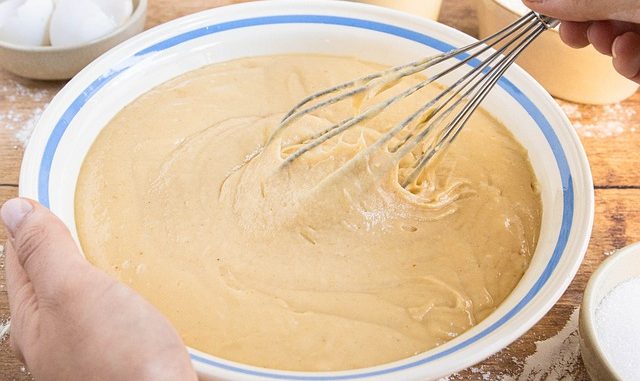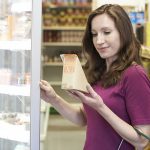
Batters or dough as we often call it are manufactured for creating cakes, muffins or other food items as well as coating pieces of fish and meat. Cake batters are usually a complex mixture of interacting ingredients. A typical cake has varying amounts of flour, eggs, fat, sugar and in some cases baking powder. There may also be emulsifiers, preservatives and other powders such as milk powder.
Understanding the flow behaviour of batters is needed for the design and operation of efficient food-processing equipment.
Preparation of A Cake Batter
Most cake ingredients are dry blended prior to incorporation into an ingredient mix. The cake ingredients are sieved to remove large particles and introduce air. Wet ingredients are then added and the batter produced is mixed for 2 minutes at maximum speed using a whisk on a kitchen-top, handheld mixer or other mixing system. Small cakes are cooked in ovens. The temperature depends on the size of the cake but muffins for example are cooked at 180C for 20 minutes. The cakes are then cooled on a tray for at least 1 hour at ambient temperature.
The Behaviour of Cake/Muffin Batters
To obtain a puffed -up volume and porous structure for any cake, means generating a stable batter in which are lodged many tiny air bubbles. These bubbles are produced during the mixing process. After mixing, the bubbles will act as nuclei and grow in size when the carbon dioxide gas generated by the baking powder leavens the product during baking. Eggs, egg white and to a lesser extent, milk proteins are important foam stabilizers, slowing down the coalescence of air bubbles. Shortening and oil is used to produce a softer structure and prevent a dry mouth feel (Lallemand Baking, 2000).
We know that gelatinization of the starch from the flour and protein denaturizing sets the structure during baking. Sucrose increases the starch gelatinization and protein denaturing temperatures, giving the cake time to rise (Hoseney, 1994).
Measurement of Rheological Properties of Cake Batter
The rheological behavior of batter is very important in cake manufacture, not only for handling purposes, but because it mainly affects the incorporation of air and the volume development of the product. Many studies have been conducted to understand how viscosity of the batter has such a controlling role. We know that the rate at which bubbles rise due to buoyancy is inversely proportional to viscosity. Thus, rapidly rising bubbles in a low-viscosity cake batter can result in cake volume loss. Higher cake batter viscosities help to incorporate more air bubbles into the batter and keep them from escaping from the mass, giving the cake system more stability.
Coalescence is the most important process by which cells disappear in porous bakery products.
The effect of ingredients on the rheological characteristics of batter is studied using a rheometer (Martínez-Cervera et al., 2012). A good example of a typical viscosity study is this following method. Batters are kept for an hour at room temperature prior to rheological analysis in order to stabilize them. This also allows the creation of gelation strength within the batter. A plate sensor of about 40 mm diameter with a serrated surface and a 1 mm gap is employed for studying flow behaviour properties. A continuous ramp is applied and apparent viscosity is measured as a function of shear rate over the 0.1– 100 second ranges, at 25ºC for 5 minutes. By plotting the graph, all curves are adjusted to Ostwald model following the power-law equation:
N = Ky´n
where N (or τ) = shear stress (Pa), K = consistency index (Pa sn) , y´ = shear rates and n = flow behaviour index. Viscoelastic properties of batter are investigated at temperature sweeps from 25°C to 95ºC, a heating rate of 1.0 ºC/minute and strain amplitude of 0.0005 (Noorlaila et al., 2020).
Oscillation amplitude sweeps are also used during rheological assessment of a batter. It is useful to measure (elastic modulus (G’), storage modulus (G’’) and complex viscosity (η*)) (Baixauli et al., 2008).
Cake Volume
The viscous behaviour of the batter system is a controlling factor in the final cake volume, due to its effects on bubble incorporation and movement (Bath et al., 1992; Handleman et al., 1961; Kim et al., 2001). The rate at which bubbles rise due to buoyancy is inversely proportional to viscosity. Thus, rapidly rising bubbles in a low-viscosity cake batter may result in cake volume loss. Higher cake batter viscosities help to incorporate more air bubbles into the batter and keep them from escaping from the mass, giving the cake system more stability. Coalescence is the most important process by which cells disappear in porous bakery products.
A sponge batter prepared by Noorlaila et al., (2020) had a flow behaviour index less than 1. This reflects on all batters that tend to show non-Newtonian behaviour i.e. they are generally shear-thinning. It also means that when a batter is subjected to increasing shear stress, the viscosity of the batter continuously decreases (Baixauli et al., 2008).
At the molecular level the ingredients in the batter align themselves with the direction of flow. Most if not all batters fit an Ostwald power law – their fit correlation coefficients are usually higher than 0.99.
Fat Replacers in Cake Batters
Fat reduction up to 80% reduces the viscosity of a cake batter (Lakshminarayan et al., 2006).
The consistency coefficient (Κ, Pa sn) decreases with the increase in the level of fat replacement except where pectin is used (Psimouli & Oreopoulou, 2013).
Surface Tension And Cake Batters
Certain factors that govern emulsion stability are also able to aid the stability of the dispersed fractions in a cake batter to small degree
It is widely known that the interfacial tension between a dispersed phase and a continuous phase is a key controlling factor of stability in batters. A high interfacial tension between two phases is probably detrimental to both emulsion and foam stability. A low interfacial tension is the result of surface-active molecules accumulating at the interface and likely to be beneficial in stabilizing such systems.
Lipid films possess a low lateral cohesion, and localised stresses in the film cause it to expand, resulting in a decrease of surfactant concentration in the region of stress and an increase in surface tension often called the Gibbs effect. A finite time is needed for surfactant molecules to diffuse to this region to restore the original surface tension which is called the Marangoni effect. The increase in surface tension my persist long enough to recover the original thickness. The absence of the Gibbs-Marangoni effect means that pure liquids do not form.
Hydrocolloids have the ability to bind between eight and ten times their own weight in water. In a batter, this is quite beneficial because these materials will increase batter viscosity. beta-glucans also raise batter viscosity similarly. Hemicelluloses have been shown to have similar surface-active properties to proteins. Izydorczyk et al., (1991) found arabinoxylans and arabinogalactans reduced the surface tension of water from 72 to 52 and 50 mN/m respectively.
Foams in Batters
Foams in batters consist of liquid lamellae filled with gas. these are destabilised and eventually destroyed by drainage of liquid from this lamellae region. This leads to film rupture.
To slow the rate at which foams collapse means drainage must be halted. Surfactants do this by creating surface tension gradients. The role that surface tension plays in creating and stabilizing foams is largely unknown. It is known that surfactants that are highly effective in reducing surface tension would be expected to stabilize a foam but in reality do not. There are others that have a similar surface activity and have a good foaming property and thus stabilize foams very effectively. The key factor is the rate at which the surface tension changes with surfactant concentration.
Globulins are mainly responsible for lowering surface tension and increasing viscosity where air is incorporated into the foam. usually, as a foam develops, the bubbles get smaller, the surface is greatly enlarged and proteins like ovomucin from egg undergo surface denaturation to form a solid foam, and the volume of the foam also increases.
Specific Gravity & Viscosity of Cake Batters
Cake batters with low specific gravity (s.g.) and high viscosity produce cakes with greater volume (Vali & Choudhary, 1990). The increase in the batter density due to a decrease in the air content incorporated into the batter decreases the storage (elastic) properties.
Different fats and oil impact both specific gravity (density) and viscosity of a cake batter.
Maltodextrin added to batter reduces the specific gravity and viscosity of the batter and the volume index of the baked cake. A cake with amylodextrin and octenyl succinylated amylodextrin shows a higher volume index .
References
Baixauli, R., Sanz, T., Salvador, A., & Fiszman, S. M. (2008). Muffins with resistant starch: Baking performance in relation to the rheological properties of the batter. Journal of Cereal Science, 47(3), pp. 502-509
et al. (1992) Fat replacers in high-ratio layer cakes. Cereal Foods World.
Soft Wheat Products. Principles of Cereal Science and Technology.
, , . (2006). Effect of maltodextrin and emulsifiers on the viscosity of cake batter and on the quality of cakes. J. Sci. Food Agric. 86(5) pp. 706–12.
Martínez-Cervera, S., Sanz, T., Salvador, A., Fiszman, S.M., 2012. Rheological textural
and sensorial properties of low-sucrose muffins reformulated with sucralose/polydextrose. LWT – Food Sci. Technol. 45, pp. 213–220 (Article).
Noorlaila, A., Hasanah, H. N., Asmeda, R., & Yusoff, A. (2020). The effects of xanthan gum and hydroxypropylmethylcellulose on physical properties of sponge cakes. Journal of the Saudi Society of Agricultural Sciences, 19(2), pp. 128-135.
Psimouli, V., & Oreopoulou, V. (2013). The effect of fat replacers on batter and cake properties. Journal of Food Science, 78(10), C1495-C1502 (Article).


Leave a Reply